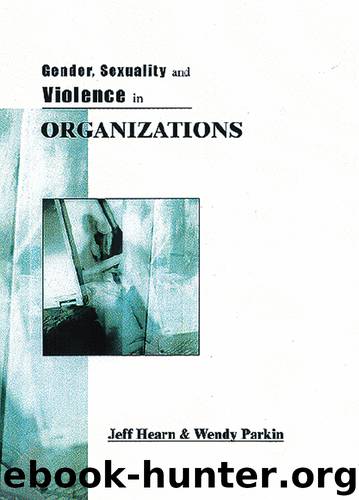Gender, Sexuality and Violence in Organizations by Hearn Jeff R; Parkin Pauline Wendy; & Wendy Parkin

Author:Hearn, Jeff R; Parkin, Pauline Wendy; & Wendy Parkin
Language: eng
Format: epub
ISBN: 254684
Publisher: SAGE Publications
Published: 2001-07-17T16:00:00+00:00
Total Institutions, Closed Organizations
We have already noted (pp. 93–4) the work of Johnson (1986) on the possible dehumanizing effects of closed, isolated organizations and the organizational and social psychological processes by which violence is reproduced. He has emphasized ‘the institutional arrangements that . . . structure situations and, to a lesser extent, develop dispositions and perceptions that (1) neutralize normal moral restraints against violence and (2) supply the motives and mechanisms necessary to carry out violence or to permit violence to occur, on a regular basis’ (p. 184). Johnson goes on to examine the situational constraints effecting authorization to harm, whether transcendent (general, often vague, akin to value-rationality) or mundane (specific, means for achieving stipulated ends, akin to instrumental rationality). Organizational crises, bureaucracy and organizational isolation are all examined in this light. He then focuses on situational socialization in and around organizations that may assist such authorizations and dehumanizations. Bureaucratic policies, statutes, legal decisions, training, procedures, routines, dispersal of responsibility and divisions of labour are all invoked in the reproduction of both the organizational conditions and the immediate psychological perceptions that facilitate violence. While Johnson’s work provides a very powerful and compelling account, it can be criticized for presenting an overly humanistic model of both persons and violation: non-violence is seen as ‘normal’ and ‘violence’ is seen as contrary to that ‘normality’. It also neglects class, ethnic, gender, sexual and indeed other social relations. However, it does clearly point to the power of bureaucracies, large impersonal institutions, heavily structured, strictly hierarchical, militaristic organizations and isolated total regimes in the construction of organization violations.
Closed organizations or total institutions involve the total or attempted control of bodies of residents, including their sexuality, as people eat, sleep, work and play under a unified organizational structure. They are defined by barriers – physical, social and/or psychological. Total institutions are not random in their recruitment across these boundaries, tending to gather the old, the young, the sick, the criminal, the poor and sometimes the very rich. The dominant divisions between public and private domains, found in many other societal arenas, are less clear or are abolished. Indeed issues of sexuality, and its possible control, are almost always significant in total institutions. Goffman’s (1961, 1969) studies of processes of institutionalization in large psychiatric hospitals and other closed organizations demonstrate how structures of control, surveillance and totality affect individual and collective behaviour.1 Compounded by isolation and separation from the outside world, they can produce conditions that contribute to violations within them, including around sexuality, gender, race and other social divisions. Processes of degradation, mortification and ‘stigmatized status’, along with resistance, adaptation and mutually hostile, if often symbiotic, staff/inmate cultures, lead to the construction of individuals with little or no voice. They are organizationally constructed as unable to ‘speak’ of the violations inflicted by the processes themselves and by those working there. Such institutionalized worlds are ‘unspoken’: those living there do not usually have a voice. This may lead to abuse continuing undetected and unchallenged over long periods of time.
Download
This site does not store any files on its server. We only index and link to content provided by other sites. Please contact the content providers to delete copyright contents if any and email us, we'll remove relevant links or contents immediately.
Hit Refresh by Satya Nadella(8863)
The Compound Effect by Darren Hardy(8523)
Change Your Questions, Change Your Life by Marilee Adams(7384)
Nudge - Improving Decisions about Health, Wealth, and Happiness by Thaler Sunstein(7255)
The Black Swan by Nassim Nicholas Taleb(6773)
Deep Work by Cal Newport(6574)
Daring Greatly by Brene Brown(6230)
Rich Dad Poor Dad by Robert T. Kiyosaki(6185)
Principles: Life and Work by Ray Dalio(5980)
Man-made Catastrophes and Risk Information Concealment by Dmitry Chernov & Didier Sornette(5659)
Playing to Win_ How Strategy Really Works by A.G. Lafley & Roger L. Martin(5524)
Digital Minimalism by Cal Newport;(5396)
Big Magic: Creative Living Beyond Fear by Elizabeth Gilbert(5360)
The Myth of the Strong Leader by Archie Brown(5243)
The Slight Edge by Jeff Olson(5202)
Discipline Equals Freedom by Jocko Willink(5159)
The Motivation Myth by Jeff Haden(5008)
Stone's Rules by Roger Stone(4866)
The Laws of Human Nature by Robert Greene(4787)
